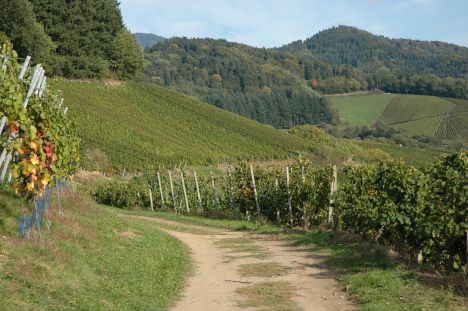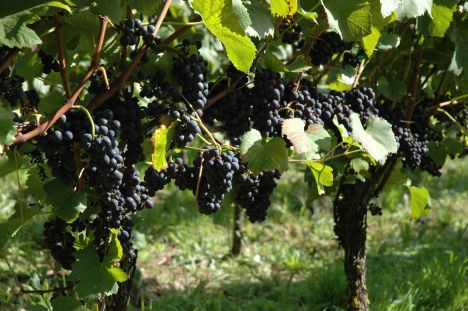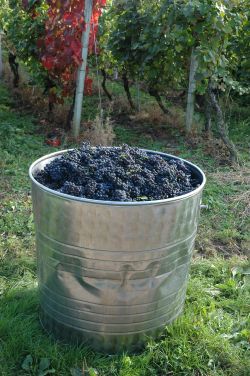With its almost 16,000 hectares of vineyards, Baden is Germany's third-largest wine-growing region. It reaches furthest south and is the only wine-growing region in Germany to belong to the European Union's wine-growing zone B, comparable to northern French regions such as Alsace, Champagne or the Loire Valley. This results in a generally higher minimum requirement for quality and Prädikat wines; the grapes must have a higher natural minimum must weight.
Baden's winegrowers can live with this, however, as Baden is demonstrably the warmest and sunniest region in Germany. The wine-growing region stretches over some 400 kilometres and is divided into the nine areas of Tauberfranken, Badische Bergstrasse, Kraichgau, Ortenau, Breisgau, Kaiserstuhl, Tuniberg, Markgräflerland and Lake Constance, as well as 16 large vineyards and 306 individual vineyards. With this scale, the wines inevitably cannot be reduced to a common denominator. However different the soils and the microclimatic conditions may be, one thing is true for the entire wine-growing region: Baden is Burgundy country.
Over 42 percent of the cultivated area is planted with the three main grape varieties from the Burgundy family, i.e. Pinot Noir, Pinot Gris (Ruländer) and Pinot Blanc. Pinot Noir is cultivated on around 5,700 hectares and is the most widely cultivated grape variety in Baden, accounting for 36 percent of the area. Not surprising really, since the cradle of the German Pinot Noir also lies here, more precisely on Lake Constance. In the royal vineyard of Bodman, the variety was introduced by Emperor Charles III in 884 as "Clävner". That is why for a long time people in Baden spoke of "Klevner" when referring to Pinot Noir.
 |
| (Photo: T. Weber) |
Pinot Noir is considered the noblest red wine grape variety in Germany. It not only makes high demands on climate and soil, but also requires a lot of care from the vintner. "Pinot Noir is a prima donna. It does not forgive any mistakes, neither in cultivation nor in vinification," says Arne Bercher from the Bercher winery in Vogtsburg-Burkheim. Despite this hardship, the Kaiserstühl winemaker accepts the challenge of Pinot Noir. With a share of 40 percent, the variety dominates the farm's portfolio.
Bercher believes that the success of Pinot Noir in Germany also has something to do with the fact that there has been a certain change in consumer taste away from bulky and towards finely structured, almost filigree red wines. "There are now real cult wines among the Spätburgunders in Germany - also in Baden," he notes with satisfaction. Some of the excellent qualities have also attracted attention abroad.
 |
| (Photo: T. Weber) |
Markus Wöhrle from the Stadt Lahr winery can only confirm this: "We are observing a trend towards high-quality Pinot Noirs that are delicate. Consumers are no longer looking for voluminous red wines." With a share of almost 30 percent of the grape variety list, Pinot Noir also takes the top position at this organically farmed estate.
Some people may be surprised at the prices that are sometimes charged for Pinot Noir. "Pinot Noir costs a little more than other wines, but that is justified," explains Wöhrle. Because its production is both time-consuming and cost-intensive. The grape variety, which prefers calcareous soils, is harvested late. Yield reduction is the top priority. "We take the strain off the vines by cutting them in half," explains the cellar master from Lahr, who will finally take over the family business next year.
 |
| (Photo: T. Weber) |
In the cellar, too, the effort is high, if only because the grapes have to be meticulously selected to obtain first-class qualities. Both unripe and overripe grapes are very detrimental to the later wine, not to mention rotten grapes, especially since botrytis further impairs the already restrained colour yield from the relatively weakly pigmented and rather thin berry skins. "In order to be able to carry out the mash fermentation, one hundred percent healthy harvest material is required," Wöhrle therefore states. And vinification in barrique barrels to further increase quality is also complex and expensive, he adds. "Barrique is still an issue when it comes to the development of Pinot Noir," Bercher makes clear and adds: "However, we are now moving away from overly intensive toasting
All of this is a prerequisite for producing high-quality, complex and extract-rich wines. And that, of course, has its price. Which, by the way, can sometimes be in the three-digit range. "Some prices of over 100 euros per bottle are high, of course, but they also strengthen the reputation of German Pinot Noirs abroad," says Bercher, pointing out that they are rather cheap compared to Burgundies from France. Twenty years ago, hardly anyone would have believed the high level of quality that German Pinot Noirs could achieve. Today, even the biggest sceptics have been proven wrong. The consumer should be grateful.
All currently tasted Pinot Noirs from Baden
All producers from Baden in the wine guide